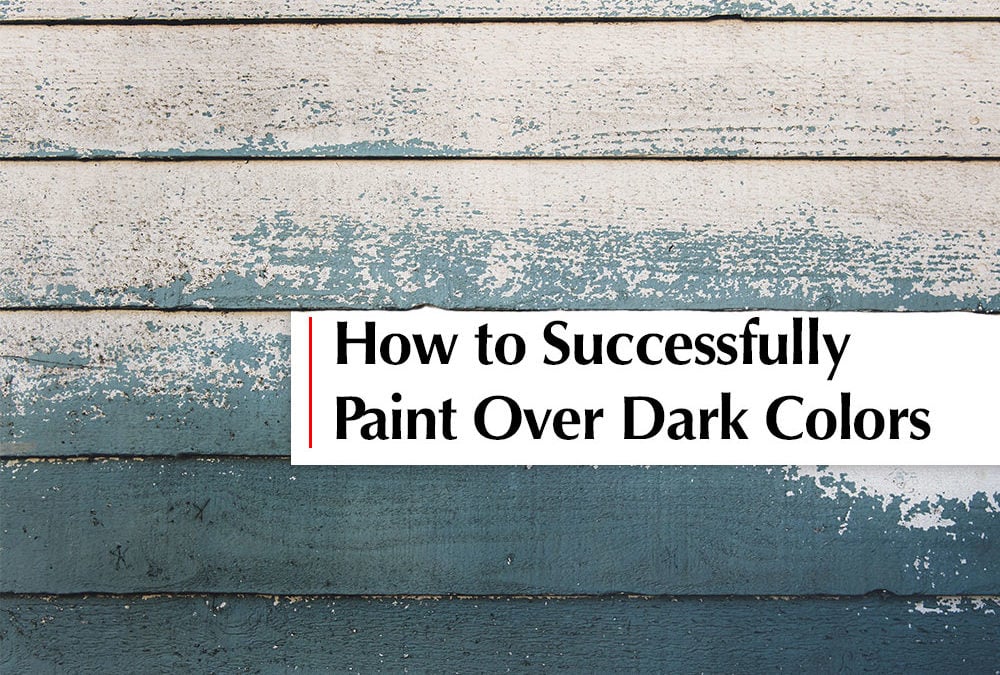How to Successfully Paint Over Dark Colors

Color Choices for Your Interior Painting Project
November 10, 2018
4 Rules of Painting a Room with Two Colors
November 24, 2018How to Successfully Paint Over Dark Colors
Dark colors look great in the right environment when you first paint them. When most homeowners pick dark colors, it’s likely because they simply fell in love with the color, it matched with a piece of furniture or carpet, or maybe because it was recommended in design/style magazine.
However, over time, just as with any paint color, your dark color will fade and maybe the trends will change. Sometimes you might just get tired of looking at the same color every day. You may surely want to repaint it, but one fact is holding you back; painting over dark colors is difficult. It can be even tougher if the dark color in question is something like deep red.
When painting over a dark color with a lighter one, many times the dark color will tend to peek through the new color. This can be quite frustrating, but it doesn’t have to be. Today, we will share some tips and steps on how to successfully paint over dark colors –whether you’re working on an exterior painting, exterior painting, cabinet repainting, door painting or trim painting. Take a look;
- Start with the right supplies
The very first step you need to do if you want to save time and sanity is to invest in the right supplies –that old paintbrush and roller alone won’t cut it. You need a roller with the right thickness or nap. Generally, the rougher the surface, the thicker your roller needs to be. Thicker roller naps are designed to hold more paint in order to apply a thicker coat and fill the crevices of bumpy surfaces.
If your walls or surfaces are dark but smooth, stick with a thinner nap. This usually gives a smooth coverage –best suited for interior painting. Choose high-quality rollers and paintbrushes if you want smoother, thicker paint coats. Lastly, choose a good quality paint that is easy to work with and will give consistent coverage –we strongly advise that you keep off cheap paints here.
- The Prep Work
When transitioning from a dark to a lighter color, preparation is extremely important. The surface needs to be as clean as possible –free of sand, dirt, grease and loose debris. Clean the walls thoroughly and scrape away any paint that’s chipping or peeling. Sand any bumpy spots on the surface too. Attempting to paint on dirty or rough dark colored surfaces is a fight you will lose before it even begins. Next, if you’re doing wall painting, run a painter’s tape along the edges between the wall and ceiling/baseboards, making sure the corners are fully covered.
- Choose the right primer
There’re many types of primers these days, all in a variety of hues for your picking. You might be tempted to use a gray primer to cover a dark-colored surface, but that is a wrong move. When going from dark to light colors, experts recommend that you use a white primer. A gray primer is suitable when transitioning from a light to a dark color.
For better concealing of the dark color, opt for a stain-blocking primer. And if you want a smoother color transition, consider tinting the primer with a small amount of your new paint. This will ensure that you use fewer coats paint thereby saving time and money on the extra cans of paint you could have used.
Lastly, make sure that you don’t go for cheap primers –quality primers contain more binders and pigments, which is what will help conceal the dark color underneath. Another option is to use a stain-blocking paint and primer combination –but this doesn’t produce the good results you will get from using each product separately. We also recommend using two coats of the primer for better coverage.
- Apply (a thick layer of) paint
One of the biggest mistakes DIY painters make when painting on dark colors is to spread the paint too thin. Remember, applying more paint amounts to better coverage. Then, when you’re painting, roll in big “W” or “M” shapes rather than just up and down. This technique gives the paint some few seconds to dry rather than covering it up again immediately.
Keep in mind that the more extreme your transition is, the more layers of paint you will need for better results. So be prepared to spend a little more time and paint on such a project. Simply, keep applying more layers until the dark color is all gone.
- Allow enough for drying
With so many coats to apply, we understand that you might get a little impatient and want to hurry things up. After all, ‘watching the paint dry’ is the most boring part of any painting project. However, boring at it may sound, you’ve got to let the paint dry between layers, so sit back, relax. Think of it as an inbuilt break that lets you rest. Failing to allow the coats to dry will simply create a mess and potentially take you back to square one.
If lightening up those dark walls sound like more than you bargained for, you can always enlist the services of repainting specialist for help. It’s much easier and cheaper (trust me) this way especially if your painting skills are less than average and don’t have all the necessary tools and equipment.





